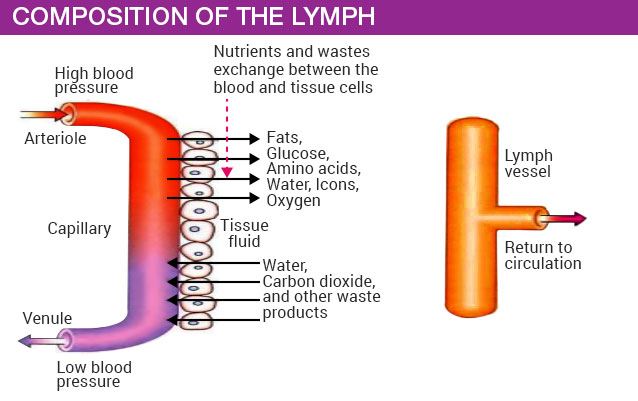Table of Contents
What is Lymph?
Lymph is a colourless fluid that circulates throughout the lymphatic system. The main role of the lymphatic system is to act as a filter against microbes, organic wastes, toxins and other debris. It carries lymphocytes throughout the body that fight against infections.
In animals and human beings, extracellular fluid (fluid outside the cell) is divided into the interstitial fluid (the fluid which exists between the tissues) and plasma. It consists of small water-soluble substances which flow in between the tissue cells. Both plasma and interstitial fluid are similar due to the continuous exchange of small solutes, water and ions across the capillary walls of the tissues.
The functions of interstitial fluid are as follows:
- It is used to transport nutrients to the cells.
- It enables intercellular communication between the cells.
- It removes the metabolic wastes from the cells.
The interstitial fluid is collected by the lymphatic system and the rest is drained out. The drained fluid moves back to the blood vessels and the remaining fluid is collected through the lymph capillaries, which is also known as lymphatic capillaries.
Let us have an overview of the composition and function of lymph in humans.
Composition of Lymph
The lymphatic system comprises lymph plasma, lymph corpuscles and lymphoid organs. The composition of lymph is described below:
Lymph Plasma
Lymph is the interstitial fluid. It has similar mineral content as in plasma. It consists of less calcium, few blood proteins, less phosphorus, and high glucose concentration. Globulin proteins which are actual antibodies are found in lymph plasma. Other substances include organic and inorganic substances. The exchange of nutrients and gases between the blood and cells of tissues occurs through the lymph.
Lymph Corpuscles
These comprise leucocytes and amoeboid cells. It contains specialised lymphocytes that are involved in eliciting immune responses in the human body.
Lymphoid Organs
The lymphatic system consists of numerous lymph nodes deep inside the body. These lymph nodes are connected to lymphatic vessels which circulate the lymph throughout the body. The lymph gets filtered at the lymph nodes.
The spleen, tonsils, adenoids and thymus all form a part of the lymphatic system. The spleen is considered the largest lymphatic organ in the system, which is located under the ribcage, above the stomach, and exactly in the left upper quadrant of the abdomen. Other parts of the lymphatic system – tonsils, adenoids and thymus are located on either side of the throat and neck.
Other Components of Lymph in Humans
- Carbohydrates
- Lymphocytes
- Creatinine
- Water – 94%
- Urea
- Chlorides
- Enzymes
- Proteins – Albumin, globulin, and fibrinogen
- Non-protein nitrogenous substances.
Also Read: Blood

Composition of Lymph
Formation of Lymph
Because lymph capillaries are permeable, lymph is formed from interstitial fluid. When blood flows through blood capillaries in the tissues, 9/10ths of the fluid flows into the venous end of the capillaries from the arterial end. The remaining one-tenth of the fluid then enters lymph capillaries, which are more permeable than blood capillaries.
As a result, when lymph passes through lymph capillaries, its composition, including protein content, is more or less similar to that of interstitial fluid. Because of their larger size, proteins found in the interstitial fluid cannot enter blood capillaries. Thus, these proteins enter lymph vessels, which are permeable to large particles.
Proteins and Fats – More protein and lipid substances are found in tissue fluid from the liver and gastrointestinal tract. As a result, large amounts of proteins and lipids enter the lymph vessels of the liver and gastrointestinal tract. As a result, lymph in larger vessels contains more proteins and lipids.
Function of Lymph
Lymph performs many important functions. A few major functions of lymph are mentioned below:
- It keeps the body cells moist.
- It transports oxygen, hormones and nutrients to different parts of the body and removes metabolic waste from the cells.
- It transports antibodies and lymphocytes to the blood.
- Maintaining the composition of tissue fluid and the volume of blood.
- Absorption of fats from the small intestine occurs through lymphatic vessels.
- Prevents invasion of microbes and foreign substances inside the lymph nodes.
Watch the below video to learn more about blood and lymph composition in humans and important questions with explanations on the topic.

Also refer: Difference Between Blood and Lymph
To know more about the composition and function of lymph in humans, keep visiting BYJU’S Biology.
Frequently Asked Questions
What are the 3 lymphatic organs?
Lymphatic organs include the spleen, thymus and tonsils.
How do you know if your lymphatic system is blocked?
Symptoms of a blocked lymphatic system include swelling, fatigue, bloating, depression and excess weight gain.
What is the function of the lymphatic system?
The function of the lymphatic system is to carry lymph throughout the body that contains infection-fighting white blood cells.
What are the components of a lymphatic system?
The lymphatic system consists of all lymphatic vessels and lymphoid organs such as the lymph nodes, thymus, spleen as well as the lymphatic tissue like Peyer’s patches and tonsils.
What is the structure and function of lymph nodes?
Lymph nodes are small, bean-shaped organs that help the immune system by filtering viruses, bacteria and other disease-causing substances that circulate through the lymphatic system.

This is a great learning and educational site, happy to find it